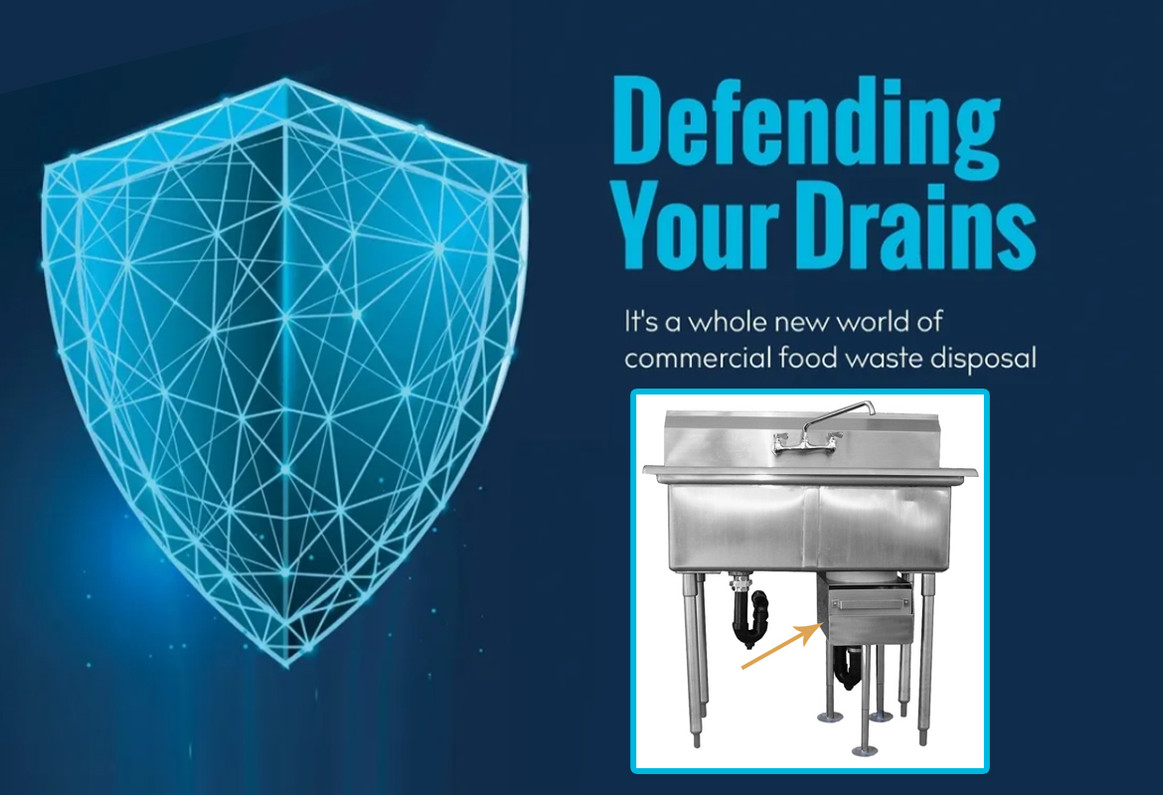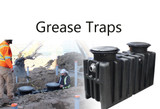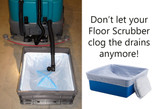Defending Your Drains
The future of Commercial Food Waste Disposal
Recent studies show that food waste costs US restaurants billions of dollars every year. It’s a problem that has gained attention recently both from restaurant leaders to lawmakers. While much of the attention is focused on food control methods, the restaurant facility manager knows there’s another hidden cost to food waste: the facility’s drains, pipes, and grease traps. The reality is that food waste is going to make its way into one of two places, the trash or the drains!
The food waste that ends up at the dishwashing or food-prep sink poses a real threat to the drains and pipes of the restaurant. For decades, the go-to product to “handle” solid food waste going down a sink drain is of course the garbage disposal (aka garbage disposer). I get it… induction motors, grinding chambers, RPM’s, horse power… the garbage disposal appeals to the Tim “The Tool Man” Taylor in all of us. But like all machinery, it can break and it will require maintenance. Motors burn out, ball bearings grind, and seals can leak. Just search YouTube for “garbage disposal not working” and you’ll find a multitude of videos with millions of views. It’s a real problem, and one that is never convenient for your restaurant.
Thankfully there is an alternative solution gaining popularity with facility managers. This alternative product goes by a number of names such as “flat strainer”, “strainer drawer”, “food scrap collector”, or quite simply a “garbage disposal replacement unit''. For our purposes we’ll call it a GDRU, but whatever the name, the product is quite simply a strainer drawer housed in a stainless steel box that is installed in between your sink drain line and your facility pipes. As the sink wastewater flows through it, the perforated strainer drawer separates and collects coarse solids, trash, silverware, and anything else that would otherwise pass through to your drains and grease trap. Instead of grinding, it catches. When it gets filled up, staff can simply pull out the strainer drawer and dump the contents directly into a trash receptacle or compost bin.
A GDRU is 100% safe with no moving parts that could cause serious injury. It is typically made of all stainless steel, doesn’t require any electricity, and can function with hot or cold water. Installation is versatile, and can be installed with an air gap so that your sink isn’t directly connected to your grease trap. They typically come in a variety of heights to fit under all types of sinks. Unlike garbage disposals, a GDRU can handle all types of food, and it won’t mangle up the silverware which inevitably ends up down a sink drain.
How it saves your pipes and helps the bottom line
To start with, a GDRU is about a third of the cost of a commercial Garbage Disposer. But the hidden savings comes with drain line maintenance and repairs. Garbage disposals can only grind and chop up food solids. They can’t prevent any food waste from entering the pipes. And as often is the case, the mushy food combined with fat, oil and grease, can solidify further down the drain pipe as it cools. These clogged pipes then require drain jetting and sometimes sections of pipe have to be fully replaced.
Savings can also be realized by reducing the amount of food solids that reach the grease interceptor. Food solids rob your interceptor of its grease holding capacity. Keeping solids out of the interceptor could allow for less frequent pum-pouts. Not to mention the added problems food scraps can cause in baffles, inlets and outlets. Food solids that settle at the bottom of a grease trap can also be a source for foul odors.
Case Studies
A major chain restaurant that was experiencing high plumbing costs due to regular drain backups. The primary culprit was food waste emanating from the dish sink and floor sink. A plumbing company was called to flush the drain lines on average once a month. During the study, total monthly plumbing costs for this one restaurant averaged about $1,000. The restaurant installed a GDRU under their sink. Additionally, they installed drain strainers in the floor sinks. Upon installation, drain jetting requirements dropped to zero and the restaurant projects an annual savings of $11,000. In addition to the cost savings, facilities managers find the GDRU is a preferred method for preventing solid food waste from getting into the drain lines because it is such an easy product to use. It takes very little training, and using it is basically common sense. It’s a win for the pipes and for operations!
Compliance, Composting, and the Cloud
Solid food waste isn’t just a problem for restaurants. State and local regulators are ramping up their efforts to prevent clogged sewer lines and cut down food waste all together. This has resulted in a multitude of regulations and bans. Some countries, counties, and municipalities have out-right banned garbage disposals. Others have banned organic food waste. Facility managers now have to consider more than just the plumbing code when it comes to food waste and drains. Unless a garbage disposal is specifically required, a GDRU can be a helpful product to save your drains and comply with regulations.
Additionally, restaurants have used GDRUs to support their composting efforts. We’ve worked with a large composting company that has helped divert 42 million lbs of food waste from landfills. They’ve recently started utilizing the GDRU in their efforts to help the foodservice industry reimagine food waste management and rebuild our country’s depleted soils. A GDRU is a simple product that can help restaurants collect kitchen food scraps sent out for composting. Certainly composting is not feasible in all situations, but the restaurants who are able to participate in composting programs reap the double benefit of keeping food solids out of their drains while promoting sustainability.
Some restaurants faced with food waste bans are turning to food waste digesters. These aerobic digesters machines can be installed on-site, and use a naturally occurring process to break down food solids into liquid wastewater (called greywater). The greywater, which is now free from solids, can then be safely discharged into the sewer system without posing a risk to clogging sewer pipes. A GDRU would aid in the collection of food solids from the restaurant sinks, allowing staff to dump the food solids into the food waste digester. As an added benefit, some digester systems provide trackable data in the “cloud”, allowing restaurants to monitor and set food waste goals to reduce food costs. A GDRU combined with a food waste digester would effectively keep solid food waste out of our pipes, sewers, and landfills, and this just might be the future of restaurant food waste disposal.
Click here to learn more and purchase a GDRU!
This article was originally published in the Facilitator Magazine Aug/Sept 2022 edition.
Recent Posts
-
What does Grease Trap do?
Grease traps, also known as grease interceptors, are plumbing devices designed to capture and separa …4th Jun 2024 -
Where to dump a Floor Scrubber?
An important aspect of operating a floor scrubber is the proper dumping of the cleaning solutio …2nd May 2024 -
Why Roof Drains Matter for Commercial Roofs
Why Drainage Matters for Commercial Flat Roofs In the case of flat or slightly pitched roofs, t …20th Sep 2023




